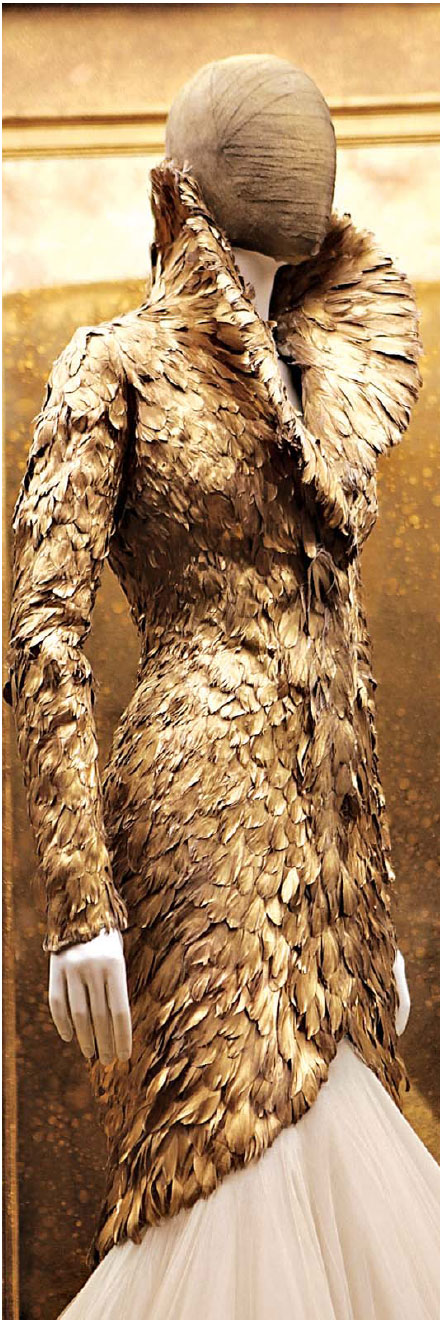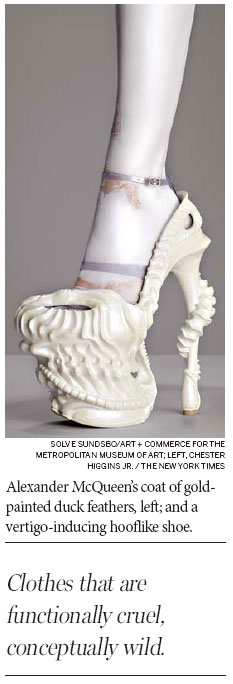People
Alexander McQueen's unfinished drama
Updated: 2011-05-22 08:29
(New York Times)

 |
"Alexander McQueen: Savage Beauty" at the Metropolitan Museum of Art in New York, a survey of the career of the British fashion designer who committed suicide last year at 40, is about control and change. The show is ethereal and gross, graceful and utterly manipulative.
Part of its dynamic is oldfashioned shock. In galleries that combine the look of baronial halls and meat lockers, clothes come at you like electrical zaps: a blouse threaded with worms, a coat sprouting horns, shoes that devour feet. A pert little jacket is printed with a crucifixion scene; a corset has a cast-metal animal spine curling out from behind.
And everywhere there are arresting delicacies. The yellow-green beadwork is so fine it looks as soft as moss. Floral-patterned lace has been cut up then partially stitched together again, to give a dress the illusion of having been torn.
The show, which drew record crowds on opening day, is a marvel. It has some of the most striking sculptures that I've seen in years, from a pillar of ivory silk organza so layered that it looks out of focus to a spacesuit ensemble embroidered with spangles.
The platform boots that go with the suit are curved like giant hooves, or like ballet slippers grotesquely swollen and frozen on point; they make an unforgettable sight, as sculpture should. They're functionally cruel, formally perfect, conceptually wild. If you can walk in them at all, they have to change the way you move through the world.
Mr. McQueen grew up in London, the son of a cabdriver. His working-class Cockney roots were, along with his homosexuality and rebelliousness, part of his insideroutsider credentials.
A virtuosic grasp of the mechanics of clothes making became early hallmarks of his design, but he quickly gained a reputation for distinctively dark, louche brilliance. He titled his graduate show"Jack the Ripper Stalks His VICTIMS,"SIGNING EACH PIECE WITH A STITCHED-IN LOCK OFHAIR.He turned to violent films for inspiration, and to tales of persecution (17th-century witch hunts) and martyrdom (Joan of Arc).
He was most interested in narratives and attention-grabbing drama. One way to get noticed was by alienating people, and the runway show for his "Highland Rape" collection of 1995-96 drew some serious criticism.
The sight of models stumbling around in torn dresses brought accusations that he was cashing in on abusive images of women. His bad-boy image intensified.
Still, he didn't stay with any one theme, though the Met show tries to give his career an organic shape by viewing it through the lens of Romanticism. An introductory gallery features wearable styles, but beyond that, clothes become costumes.
The next gallery has a fancy gift-shop look, with McQueen-commissioned fashion accessories,mong them an extravagant,butterfly hat by Philip Treacy and jiwelry- the backboned corset,a silver crown of thorns-by Shaun Leane. Most absorbing, though, are the videos of his runway shows.
In one, a model stands on a revolving platform as two robotic machines aggressively spray her with paint. In another, a model staggers, bare breasted, into an artificial blizzard as her kimonolike robe balloons out behind her. Just beyond this room are the outfits from "Highland Rape."
Mr. McQueen repeatedly said that his intention was to "empower women" through his designs, though the impression often is that he's tormenting them. His insistence on political content is one of the slipperiest and least resolved aspects of his work.
And although he grumbled about racist stereotyping in Western fashion, he perpetuated such stereotypes in his Asian- and African-derived designs.
Future researchers will want to take Mr. McQueen out of the tent of Romanticism and place him firmly in the cultural milieu he shared with artists like Damien Hirst and Matthew Barney, not to mention Lady Gaga, with her cutlet couture.
And why not compare him with other politically minded designers? Mr. McQueen deserves this detailed accounting.
Specials

Suzhou: Heaven on Earth
Time-tested adages sing praises of Suzhou, and Michael Paul Franklin finds it's not hard to understand why on a recent visit.

The sky's the limit
Chinese airline companies are increasingly recruiting pilots and flight attendants as the industry experiences rapid expansion.

Diving into history
China's richest cultural heritage may lie in the deep, like exhibits in a giant underwater museum.